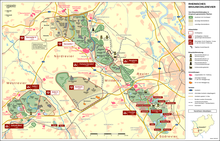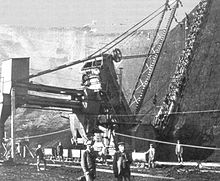Gruhlwerk
The Gruhlwerk (full name: Gruhl'sches Braunkohlen- und Briquettwerk ) was a lignite mining and processing company in the Ville in the Rhenish Revier . The company operated several pits and briquette factories near the Brühl districts of Heide and Kierberg .
The company, which was built up by Hermann Gruhl and Hermann Bleibtreu in 1874, is considered a pioneer in industrial lignite extraction and processing beyond the Rheinische Revier. In 1908 it merged into RAG , later known as Rheinbraun .
history
The company was founded at the time when the pre-industrial lignite mining in Kuhlen- und Tummelbau , driven by the increasing demand for new briquette factories, was being replaced by the first larger open-cast mines. Lignite was previously used not only for domestic fuel but also for the production of alum . At the beginning of the 1870s, the chemist Hermann Bleibtreu , who owned an alum smelter near Bonn and a large lignite field near Brühl, planned to use the lignite to press briquettes instead of extracting alum. He won over the entrepreneur Hermann Gruhl, who had previously been successfully active in the Central German district, as a financier . Gruhl and Bleibtreu formed the Bleibtreu lignite union in 1874 , which Gruhl continued to run on his own after the death of his partner Bleibtreu in 1882.
In 1889 Gruhl founded the company under his own name and built two briquette factories Gruhlwerk I and II between 1889 and 1895 near Heide and Kierberg on the Mödrath-Liblar-Brühl railway line , which were built from the pit fields of the Bleibtreu union and Friederike V's own fields , Morgensonne I and II as well as Weilerswist II were supplied with coal.
In the 1890s, the Gruhlwerk, like its local competitors Roddergrube , Grube Brühl , Berggeist and Donatus and all other plants in the area, had to contend with overcapacity and a sharp drop in prices despite increasing demand. This culminated in the establishment of a syndicate in 1889 , the sales association of the Rheinische Braunkohlen-Briquettwerke . The briquettes were sold at a fixed price under the common brand Union-Brikett .
Around 1900 several new briquette plants were built in the area, but they did not join the sales association. As a result of this and an economic downturn with the following sales crisis, another battle flared up between the lignite plants, which ultimately led to concentration . After the Gruhl work under the leadership of Carl Gruhl , the son of the founder, in 1905, first the pit Donatus had taken over, it merged in 1908 with the Fortuna AG to Rheinische AG for brown coal mining and briquette (RAG) , which later Rheinbraun and still later the division Lignite production by RWE Power was.
Throughout its existence, the Gruhlwerk promoted lignite mining and processing. So the first thing to do was to operate the opencast mine with large cutting excavators and innovative conveyor technology such as a new type of rack railway or the first electric locomotive. Furthermore, in cooperation with Ferdinand August Schulz , the further development of lignite drying and briquetting was promoted.
Today the former briquette factories have been completely demolished. A few remaining lakes, including the Gruhlsee and Bleibtreusee, are reminiscent of the open-cast mines .
literature
- Fritz Wündisch: From the history of the Gruhlwerk . In: Brühler Heimatblätter . tape 26 , no. 1 . Brühler Heimatbund, Brühl 1969, DNB 012171549 , p. 31-34 .
Individual evidence
- ^ A b Diane Dammers: The formation of cartels in the Rhenish brown coal industry (1871-1914) . Thesis. Faculty of Economics and Social Sciences at the University of Cologne, Cologne 2003.
- ↑ Hendrik Fischer: Lignite mining and the industrialization of Brühl , diploma thesis, Faculty of Economics and Social Sciences at the University of Cologne, Cologne, 2003
- ↑ Hans Baumgärtel and Erich Rammler: 100 years of brown coal briquetting , Fuel Technology Society in the German Democratic Republic (ed.), VEB Wilhelm Knapp Verlag, Halle (Saale), 1958, excerpts online at home.arcor.de/s.lintzmeyer ( Memento from December 1, 2011 in the Internet Archive )



